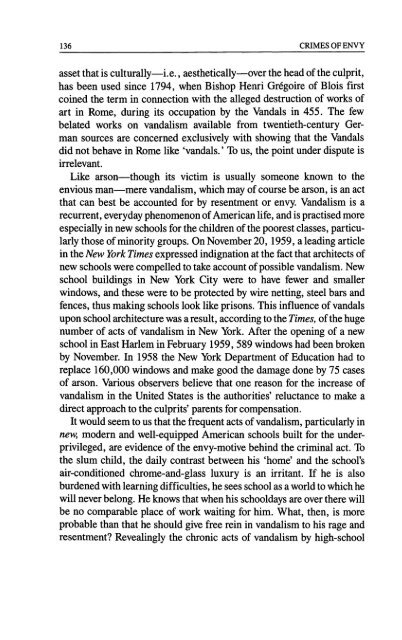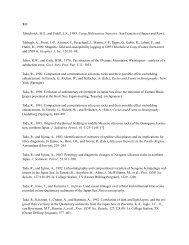- Page 2:
.: .. ENVY
- Page 6 and 7:
ENVY A Theory of Social Behaviour b
- Page 8 and 9:
Contents 1 MAN THE ENVIER The world
- Page 10 and 11:
CONTENTS United States presidential
- Page 12:
ENVY
- Page 15 and 16:
4 MAN THE ENVIER Although some scho
- Page 17 and 18:
6 MAN THE ENVIER standard full prof
- Page 19 and 20:
8 MAN THE ENVIER consequence of our
- Page 21 and 22:
10 MAN THE ENVIER values and inequa
- Page 23 and 24:
12 MAN THE ENVIER substitutes for e
- Page 26 and 27:
ACTING AS THOUGH THERE WERE NO ENVY
- Page 28 and 29:
2 Envy in Language Born IN LITERATU
- Page 30 and 31:
ENVY AND JEALOUSY IN ENGLISH 19 see
- Page 32 and 33:
ENVY AND EMULATION 21 dissatisfacti
- Page 34 and 35:
CAUSAL DELUSION IN ENVY 23 pete. Bu
- Page 36 and 37:
A DEFINITION IN GERMAN 25 start som
- Page 38 and 39:
ENVY IN PROVERBS 27 Envy is always
- Page 40 and 41:
IMPUTATION OF ENVIOUS MOTIVES 29 fa
- Page 42 and 43:
CONFESSING ONE'S ENVY 31 employees
- Page 44 and 45:
3 The Envious Man and His Culture N
- Page 46 and 47:
ARE ANY SOCIETIES DEVOID OF ENVY? 3
- Page 48 and 49:
ARE ANY SOCIETIES DEVOID OF ENVY? 3
- Page 50:
ARE ANY SOCIETIES DEVOID OF ENVY? 3
- Page 53:
42 ENVY AND BLACK MAGIC hospitality
- Page 56 and 57:
ENVY AND SUSPECTED WITCHCRAFT 45 fo
- Page 58 and 59:
THE ENEMY IN OUR MIDST 47 someone b
- Page 61:
50 ENVY AND BLACK MAGIC ability to
- Page 64 and 65:
BLACK MAGIC VERSUS PERSONS UNKNOWN
- Page 67 and 68:
56 ENVY AND BLACK MAGIC puts in the
- Page 69 and 70:
58 THE ENVY-BARRIER OF THE DEVELOPI
- Page 71 and 72:
60 THE ENVv,.BARRIER OF THE DEVELDP
- Page 73:
62 THE ENVv,.BARRIER OF THE DEVELOP
- Page 76 and 77:
THE BUYER IS A THIEF 65 The buyer i
- Page 78:
'LOSS OF FACE' IN CHINA AND AVOIDAN
- Page 81:
70 THE ENVv,.BARRIER OF THE DEVELOP
- Page 85 and 86:
74 THE ENVY:BARRIER OF THE DEVELOPI
- Page 87 and 88:
76 THE ENVY-BARRIER OF THE DEVELOPI
- Page 89 and 90:
78 THE PSYCHOLOGY OF ENVY possessio
- Page 91 and 92:
80 THE PSYCHOLOGY OF ENVY It would,
- Page 93 and 94:
82 THE PSYCHOLOGY OF ENVY same time
- Page 95 and 96: 84 THE PSYCHOLOGY OF ENVY sexual or
- Page 97 and 98: 86 THE PSYCHOLOGY OF ENVY jealousy
- Page 99 and 100: 88 THE PSYCHOLOGY OF ENVY male and
- Page 101 and 102: 90 THE PSYCHOLDGY OF ENVY tension,
- Page 103 and 104: 92 THE PSYCHOLOGY OF ENVY first ser
- Page 105 and 106: 94 THE PSYCHOLOGY OF ENVY submarine
- Page 107 and 108: 96 THE PSYCHOLOGY OF ENVY It is not
- Page 109 and 110: 98 THE PSYCHOLOGY OF ENVY Experimen
- Page 111 and 112: 100 THE PSYCHOLOGY OF ENVY Reminded
- Page 113 and 114: 102 THE PSYCHOLOGY OF ENVY extreme
- Page 115 and 116: 104 THE PSYCHOLDGY OF ENVY directed
- Page 118 and 119: INDIVIDUAL AND GROUP 107 This view
- Page 120 and 121: POWER AND CONFORMITY 109 change, it
- Page 122 and 123: ENVY IN THE SOCIOLOGY OF CONFLICT 1
- Page 124 and 125: SOCIOLOGICAL AMBIVALENCE 113 victio
- Page 126 and 127: GEORG SIMMEL ON ENVY 115 diminished
- Page 128 and 129: BEGRUDGING OTHERS THEIR ASSETS 117
- Page 131 and 132: 120 ENVY AS SEEN BY THE SOCIAL SCI
- Page 133 and 134: 122 ENVY AS SEEN BY THE SOCIAL SCIE
- Page 135 and 136: 124 ENVY AS SEEN BY THE SOCIAL SCIE
- Page 138 and 139: WHY A SOCIETY OF UNENVIOUS EQUALS?
- Page 140 and 141: Murder from envy 8 Crimes of Envy A
- Page 142 and 143: MURDER FROM ENVY 131 In August 1959
- Page 144 and 145: MURDER FROM ENVY 133 When questione
- Page 148 and 149: ENVIOUS BUILDING 137 students, typi
- Page 150 and 151: VENGEFUL VIOLENCE 139 cissism (whic
- Page 153 and 154: 142 THE ENVY OF THE GODS AND THE CO
- Page 155 and 156: 144 THE ENVY OF THE GODS AND THE CO
- Page 157: 146 THE ENVY OF THE GODS AND THE CO
- Page 160 and 161: NEMESIS 149 means is dislike, a gen
- Page 162 and 163: ACTING IN THE FACE OF DIVINE ENVY 1
- Page 164 and 165: 'PLEASURE IS FORBIDDEN!' 153 'Pleas
- Page 167 and 168: 156 THE ENVY OF THE GODS AND THE CO
- Page 169 and 170: 158 THE ENVY OF THE GODS AND THE CO
- Page 172 and 173: NEW TESTAMENT ETHICS AND THE MODERN
- Page 174 and 175: HERMAN MELVILLE 163 prives him of t
- Page 176 and 177: HERMAN MELVILLE subject of worldly
- Page 178 and 179: THE RELUCTANCE TO ATTRIBUTE ENVY 16
- Page 182 and 183: THE BLIND SPOT IN MELVILLE SCHOLARS
- Page 184 and 185: EUGENE SUE'S FREDERICK BASTIEN: ENV
- Page 186 and 187: A PSYCHOTHERAPY OF ENVY 175 conscio
- Page 188 and 189: YURI OLESHA'S ENVY: THE PROBLEM OF
- Page 190: 'THINGS DON'T LIKE ME' 179 trays, i
- Page 193: 182 THE ENVIOUS MAN IN FICTION Labo
- Page 196 and 197:
ENVY AND EQUALITY IN UTOPIA 185 rid
- Page 198 and 199:
ENVY AND EQUALITY IN UTOPIA 187 dis
- Page 200 and 201:
CHAUCER AND MILTON 189 writers to b
- Page 202:
ENVIOUS INTRIGUE AMONG LITERATI Wat
- Page 205 and 206:
11 Envy as the Subject· of Philoso
- Page 207 and 208:
196 ENVY AS THE SUBJECT OF PHILOSOP
- Page 210 and 211:
A MORTGAGE WITH THE WORLD BANK OF F
- Page 212 and 213:
IMMANUEL KANT 201 Schadenfreude. '
- Page 214 and 215:
THE PSYCHOLOGY OF INGRATITUDE 203 p
- Page 216 and 217:
THE PSYCHOWGY OF INGRATITUDE 205 th
- Page 218:
SOREN KIERKEGAARD 207 Schopenhauer
- Page 221 and 222:
210 ENVY AS THE SUBJECT OF PHILOSOP
- Page 224 and 225:
FRIEDRICH NIETZSCHE 213 attributed
- Page 226 and 227:
SCHADENFREUDE 215 private parts of
- Page 228 and 229:
RESENTMENT 217 fatigable and insati
- Page 230 and 231:
RESENTMENT AND REVENGE 219 ing Niet
- Page 232 and 233:
RESENTMENT TYPES 221 the absence ei
- Page 235 and 236:
224 ENVY AS THE SUBJECT OF PHIlDSOP
- Page 238 and 239:
ENVY-INDIGNATION By definition, the
- Page 240 and 241:
ENVY IN FRANCE 229 of Raiga's obser
- Page 242 and 243:
ENVIOUS POLITICAL PARTIES 231 vanqu
- Page 245 and 246:
234 POLITICS AND THE APPEASEMENT OF
- Page 247 and 248:
236 POLITICS AND THE APPEASEMENT OF
- Page 249 and 250:
238 POLITICS AND THE APPEASEMENT OF
- Page 251 and 252:
240 POLITICS AND THE APPEASEMENT OF
- Page 253 and 254:
242 POLITICS AND THE APPEASEMENT OF
- Page 255 and 256:
244 POLITICS AND THE APPEASEMENT OF
- Page 257 and 258:
246 POLITICS AND THE APPEASEMENT OF
- Page 260 and 261:
OSTRACISM-DEMOCRACY AND ENVY IN ANC
- Page 262 and 263:
OSTRACISM-DEMOCRACY AND ENVY IN ANC
- Page 264 and 265:
13 In Praise of Poverty: from Sumpt
- Page 266 and 267:
GOETHE'S 'CRIME' 255 held to be per
- Page 268 and 269:
SOCIAL AGNOSTICISM 257 there are po
- Page 270 and 271:
LUXURY 259 Next, I would ask: 'Woul
- Page 272 and 273:
PROHIBITIONS ON LUXURY 261 universa
- Page 274 and 275:
TO INDULGE IN LUXURY IS TO PROVOKE
- Page 276 and 277:
'CONSPICUOUS CONSUMPTION' 265 initi
- Page 278 and 279:
HOW LUXURY REMAINS POLITICALLY ACCE
- Page 281 and 282:
270 IN PRAISE OF POVERTY Many of th
- Page 283 and 284:
272 IN PRAISE OF POVERTY The recogn
- Page 285 and 286:
274 IN PRAISE OF POVERTY The oppres
- Page 287 and 288:
276 IN PRAISE OF POVERTY qualificat
- Page 289:
278 THE SENSE OF JUSTICE AND THE ID
- Page 294 and 295:
FREEDOM AND EQUALITY 283 demanded,
- Page 296 and 297:
GOOD AND BAD LUCK, CHANCE AND OPPOR
- Page 298 and 299:
EQUALITY OF OPPORTUNITY 287 'It is
- Page 300 and 301:
EQUALITY OF OPPORTUNITY 289 intelli
- Page 302 and 303:
INEQUALITY OF OPPORTUNITY AS AN ALI
- Page 304 and 305:
'SOCIAL JUSTICE'-PRIVATE PATIENTS B
- Page 306 and 307:
BOGUS EQUALITY AND CONSPICUOUS CONS
- Page 308 and 309:
SOCIALISM AND ENVY 297 is in any ca
- Page 311 and 312:
300 THE SENSE OF JUSTICE AND THE ID
- Page 313 and 314:
302 THE SENSE OF JUSTICE AND THE ID
- Page 315 and 316:
304 THE SENSE OF JUSTICE AND THE ID
- Page 317 and 318:
306 THE SENSE OF JUSTICE AND THE ID
- Page 319 and 320:
15 The Guilt of Being Unequal THE G
- Page 321 and 322:
310 THE GUILT OF BEING UNEQUAL 'Mor
- Page 323 and 324:
312 THE GUILT OF BEING UNEQUAL Here
- Page 325 and 326:
314 THE GUILT OF BEING UNEQUAL does
- Page 327 and 328:
316 THE GUILT OF BEING UNEQUAL reca
- Page 329 and 330:
318 THE GUILT OF BEING UNEQUAL Tour
- Page 332:
ETHICS-SENSIBILITY OR SENSE? 321 ea
- Page 335 and 336:
324 THE GUILT OF BEING UNEQUAL mizi
- Page 337 and 338:
326 THE GUILT OF BEING UNEQUAL avoi
- Page 339 and 340:
328 THE EMINENT IN THE SOCIETY OF E
- Page 341 and 342:
330 THE EMINENT IN THE SOCIETY OF E
- Page 343 and 344:
332 THE EMINENT IN THE SOCIETY OF E
- Page 345 and 346:
334 THE EMINENT IN THE SOCIETY OF E
- Page 347 and 348:
336 THE EMINENT IN THE SOCIETY OF E
- Page 349 and 350:
338 THE EMINENT IN THE SOCIETY OF E
- Page 351 and 352:
340 THE EMINENT IN THE SOCIETY OF E
- Page 353 and 354:
342 THE SOCIETY REDEEMED FROM ENVY-
- Page 355 and 356:
344 THE SOCIETY REDEEMED FROM ENVY-
- Page 357 and 358:
346 THE SOCIETY REDEEMED FROM ENVY-
- Page 360 and 361:
CHILDREN OF THE KIBBUTZ 349 envy. T
- Page 362 and 363:
CHILDREN OF THE KIBBUTZ 351 members
- Page 364 and 365:
THE SIN OF PRIVACY 353 fessors. Not
- Page 366 and 367:
JEALOUSY IN THE GROUP 355 attained,
- Page 368 and 369:
FREEDOM FROM ENVY, A TASK FOR THE I
- Page 370 and 371:
UTOPIAS 359 Utopias The kibbutzim,
- Page 372 and 373:
18 Is Ownership Theft? SOCIALISM CO
- Page 374 and 375:
THE ECONOMIC POLICY OF THE LEAST EN
- Page 376 and 377:
WELFARE ECONOMICS 365 Welfare econo
- Page 378 and 379:
WELFARE ECONOMICS 367 In his notes,
- Page 381 and 382:
370 IS OWNERSHIP THEFT? journalists
- Page 383 and 384:
372 IS OWNERSHIP THEFT? Significant
- Page 385 and 386:
374 IS OWNERSHIP THEFT? the wonderf
- Page 387 and 388:
376 IS OWNERSHIP THEFT? steel mills
- Page 389 and 390:
378 SOCIAL INDIGNATION been infrequ
- Page 391 and 392:
380 SOCIAL INDIGNATION no moral fee
- Page 393 and 394:
382 SOCIAL INDIGNATION begrudging u
- Page 395 and 396:
384 SOCIAL INDIGNATION that we shal
- Page 397:
386 ENVY AS TAX COLLECTOR If antipa
- Page 400 and 401:
PROGRESSIVE TAXATION 389 executive
- Page 403 and 404:
392 ENVY AS TAX COLLECTOR hope of p
- Page 405 and 406:
21 Social Revolutions WHICH SOCIAL
- Page 407 and 408:
396 SOCIAL REVOLUTIONS revolution o
- Page 409:
398 SOCIAL REVOLUTIONS the United S
- Page 413 and 414:
402 SOCIAL REVOLUTIONS prevalence a
- Page 415 and 416:
404 SOCIAL REVOLUTIONS follow his e
- Page 417 and 418:
406 SOCIAL REVOLUTIONS better to ad
- Page 419 and 420:
408 SOCIAL REVOLUTIONS We are given
- Page 421 and 422:
410 SOCIAL REVOLUTIONS peasant ·co
- Page 423 and 424:
412 SOCIAL REVOLUTIONS There is als
- Page 425 and 426:
414 A THEORY OF ENVY IN HUMAN EXIST
- Page 427 and 428:
416 A THEORY OF ENVY IN HUMAN EXIST
- Page 429 and 430:
418 A THEORY OF ENVY IN HUMAN EXIST
- Page 431 and 432:
420 A THEORY OF ENVY IN HUMAN EXIST
- Page 433 and 434:
422 A THEORY OF ENVY IN HUMAN EXIST
- Page 437 and 438:
426 A THEORY OF ENVY IN HUMAN EXIST
- Page 440 and 441:
A Selected Bibliography For complet
- Page 442 and 443:
A SELECTED BIBLIOGRAPHY 431 Fromm,
- Page 444 and 445:
A SELECTED BIBLIOGRAPHY 433 Lorenz,
- Page 446 and 447:
A SELECTED BIBLIOGRAPHY 435 Simmel,
- Page 448:
Index
- Page 451 and 452:
440 Curle, A., 291 Curran, c., 182,
- Page 454 and 455:
absenteeism and group size, 421-422
- Page 456 and 457:
INDEX egalitarian attitudes, 258, 3
- Page 458 and 459:
INDEX Futterneid,91-95 future, 53,
- Page 460 and 461:
INDEX misfortune, 47, 63, 425 poten
- Page 462 and 463:
INDEX social conflict, 13,31,110-11
- Page 465:
The text of this book is set in Tim




